IMR_User_Guide_For_Industry
IMR_User_Guide_For_Industry.docx
Federal Fish and Wildlife Permit Applications and Reports--Migratory Birds and Eagles; 50 CFR 10, 13, 21, 22
IMR_User_Guide_For_Industry
OMB: 1018-0022
Injury and Mortality Reporting (IMR) System User Guide for Industry Users
Table of Contents
Creating an Injury/Mortality Record and Exporting a Record Summary
Creating a Nest Removal/Relocation Record and Exporting a Record Summary
Supporting Documents/Guidance in IMR
What to do if You Discover and Eagle or a Threatened or Endangered Species (attached separately)
What to do if You Discover a Bird that is not an Eagle or a Threatened and Endangered Species (attached separately)
Answers to Questions Frequently Asked by Companies Reporting Bird Injuries and Mortalities - (attached separately)
Nest Reporting Instructions - (attached separately)
IMR Injury and Mortality Example Import File – (attached separately)
List of all Required and Optional Fields Supported by the Bulk Uploader
To request an account, users will go to: https://ecos.fws.gov/imr/welcome
Click on “request an account”
Fill out the following short form:

Upon receiving your request, the helpdesk will send you instructions on how to open an account
IMR contains help for each field (pictured below for the “latitude” field) that will help users know what’s expected for that field. Help is also provided above the form, including links to any appropriate guidance documents or other relevant information. As seen below, several guidance documents are provided including guidance for:
Privacy and Freedom of Information Act (FOIA), What to do if You Discover and Eagle or a Threatened or Endangered Species (attached separately), What to Do if You Discover a Bird that is not an Eagle or a Threatened and Endangered Species (attached separately), and Answers to Questions Frequently Asked by Companies Reporting Bird Injuries and Mortalities (attached separately). Nest Reporting Instructions (attached separately) are also offered on the Nest report form page.
Help information is also provided on
the top of each of the forms. Help can be turned on and off by
clicking on the question mark to the right of the “Help Topics”
button.

Users must create a Project record before they will be able to save injury/mortality records or nest records.
Multiple individuals can be added by a user as a “Project User” for a particular project in their account. “Project Users” are able to see that project and all records logged under it in their IMR account. They will also be able to add and edit records under that project. A user can add any user that has an account in IMR as a “Project User”. Once the individual a user wishes to add has an account in IMR, the user may simply start typing their e-mail address to find and add them.
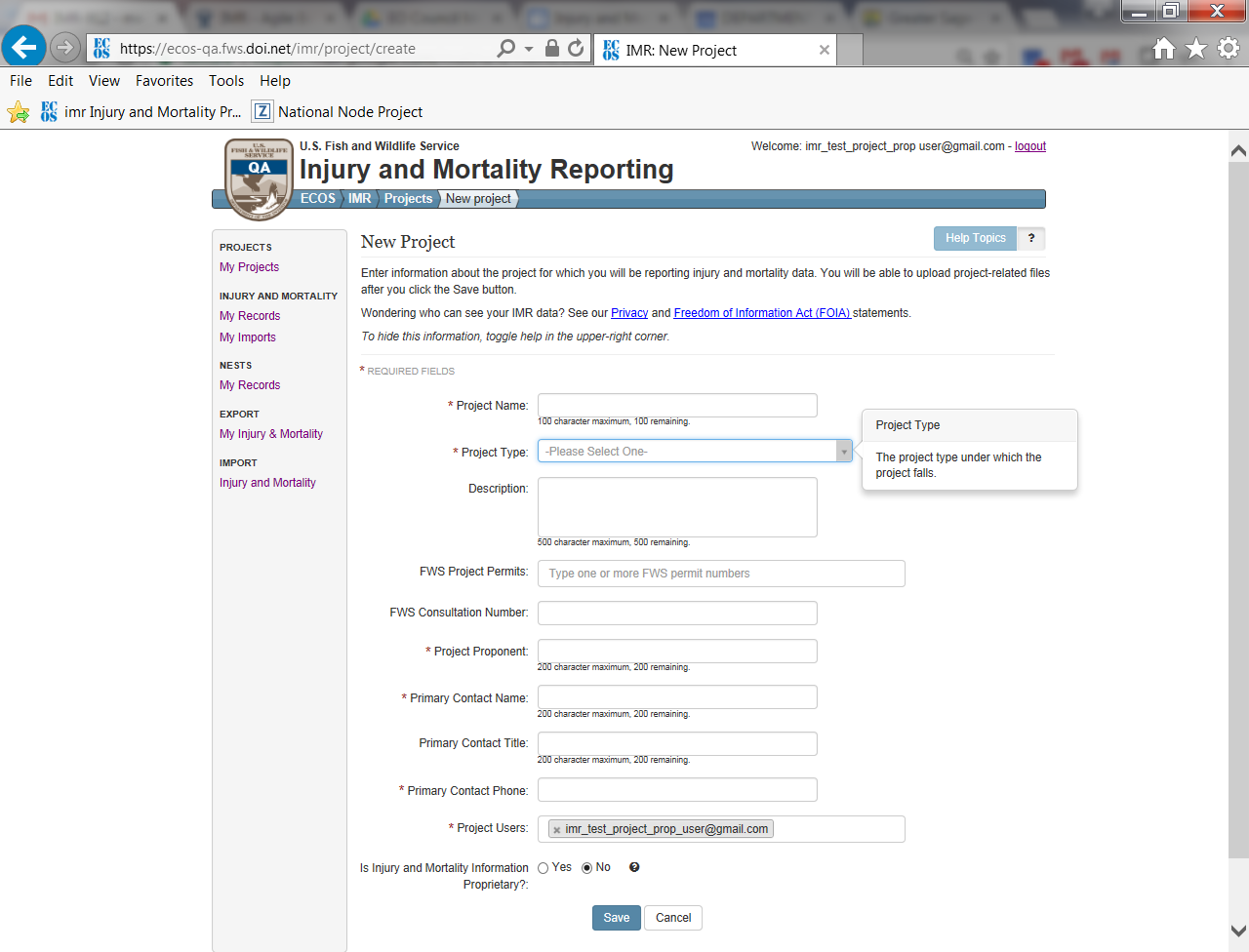
Once a project is created, users can then start entering injury/mortality or nest relocation/removal records directly from the project summary screen by clicking on the “Injury and mortality records” or “Nest Removal and Relocation records” buttons pictured below. Alternately, they can click on the “My Records” option in the “INJURY and MORTALITY” or “NESTS” section on the menu bar to the left and start creating records:

Creating an Injury/Mortality Record and Exporting a Record Summary:
If the user opens the form from the Project summary view (above) the project field will automatically be populated with the project name. However, if the user chooses the “My Records” menu option and decides to create records that way, they will have to select the project they’ve created from the drop down menu on the injury/mortality report form. The injury/mortality form has a total of 12 required fields. These must be filled out before the record can be saved. The full form including all fields is included on the next few pages.



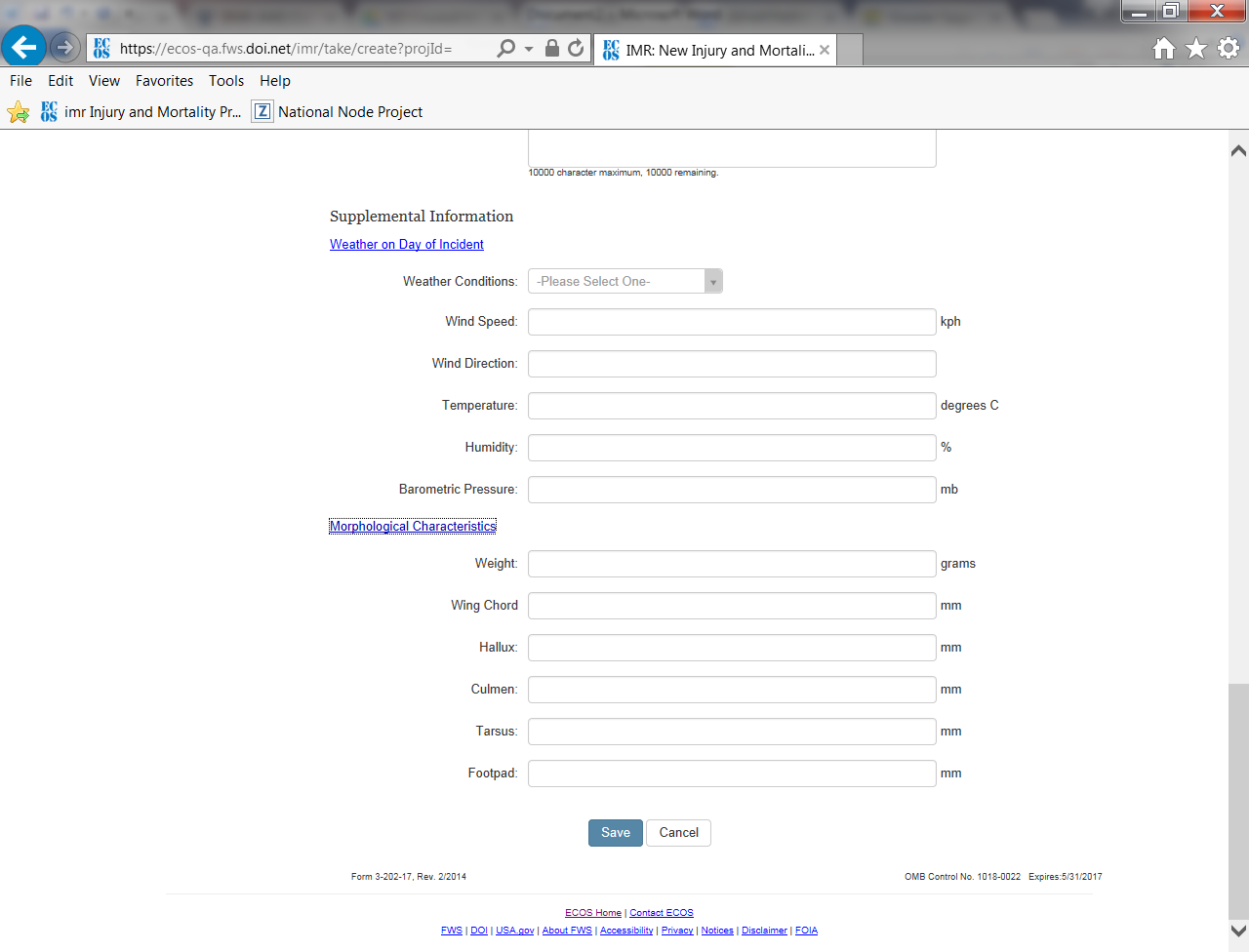
Once created, injury/mortality records are viewable in list view as pictured below, and a summary of the data can be exported by clicking on the Excel and Pdf icons pictured below at the bottom of the records list.

The Excel version of the summary is formatted as pictured below. Anyone listed as a Project User on the project can view the full details associated with the record by copying and pasting the hyperlink pictured below in column E into their web browser. The user will be prompted to log into IMR to view the record details:
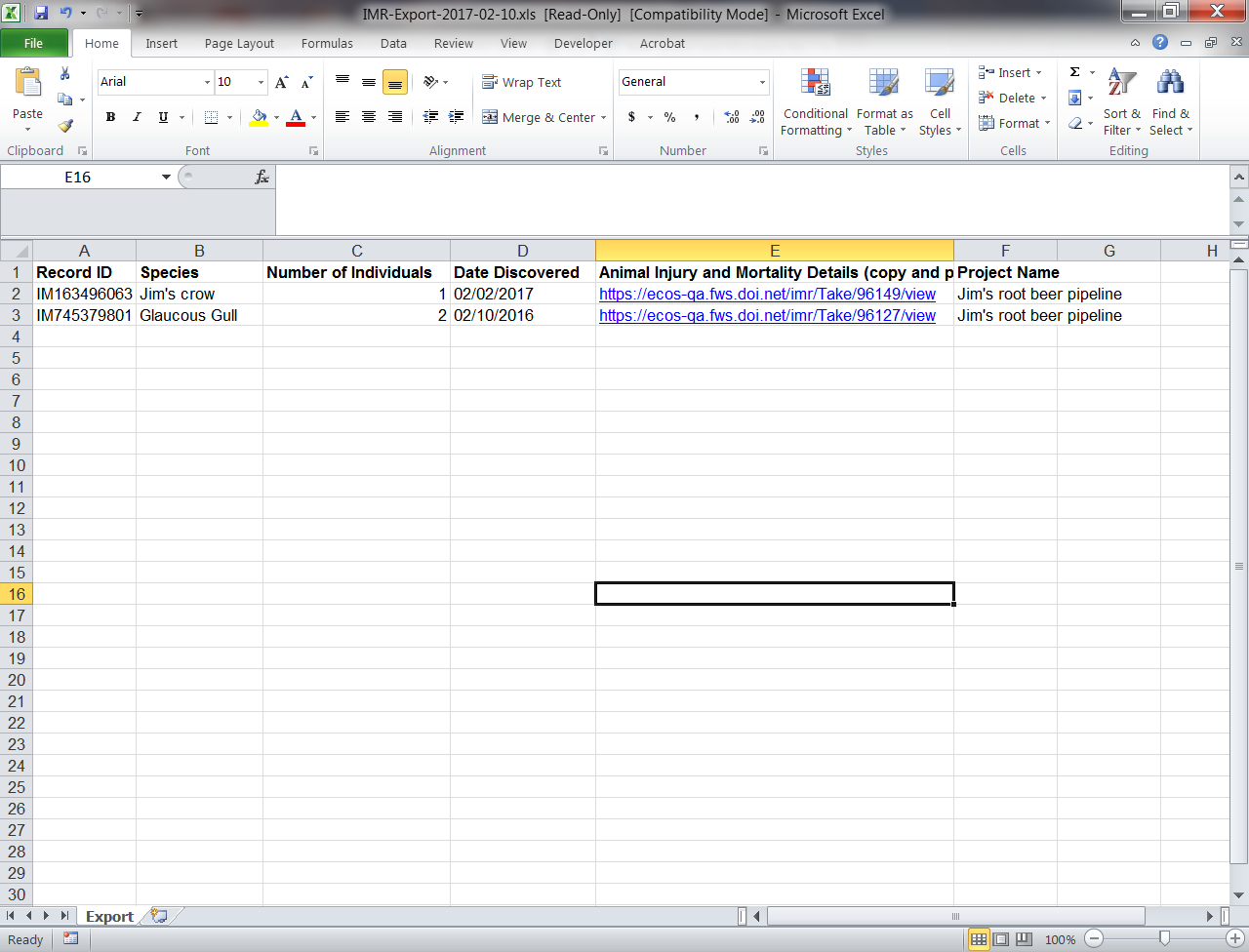
The Pdf version of the report is the same general format as the Excel version:
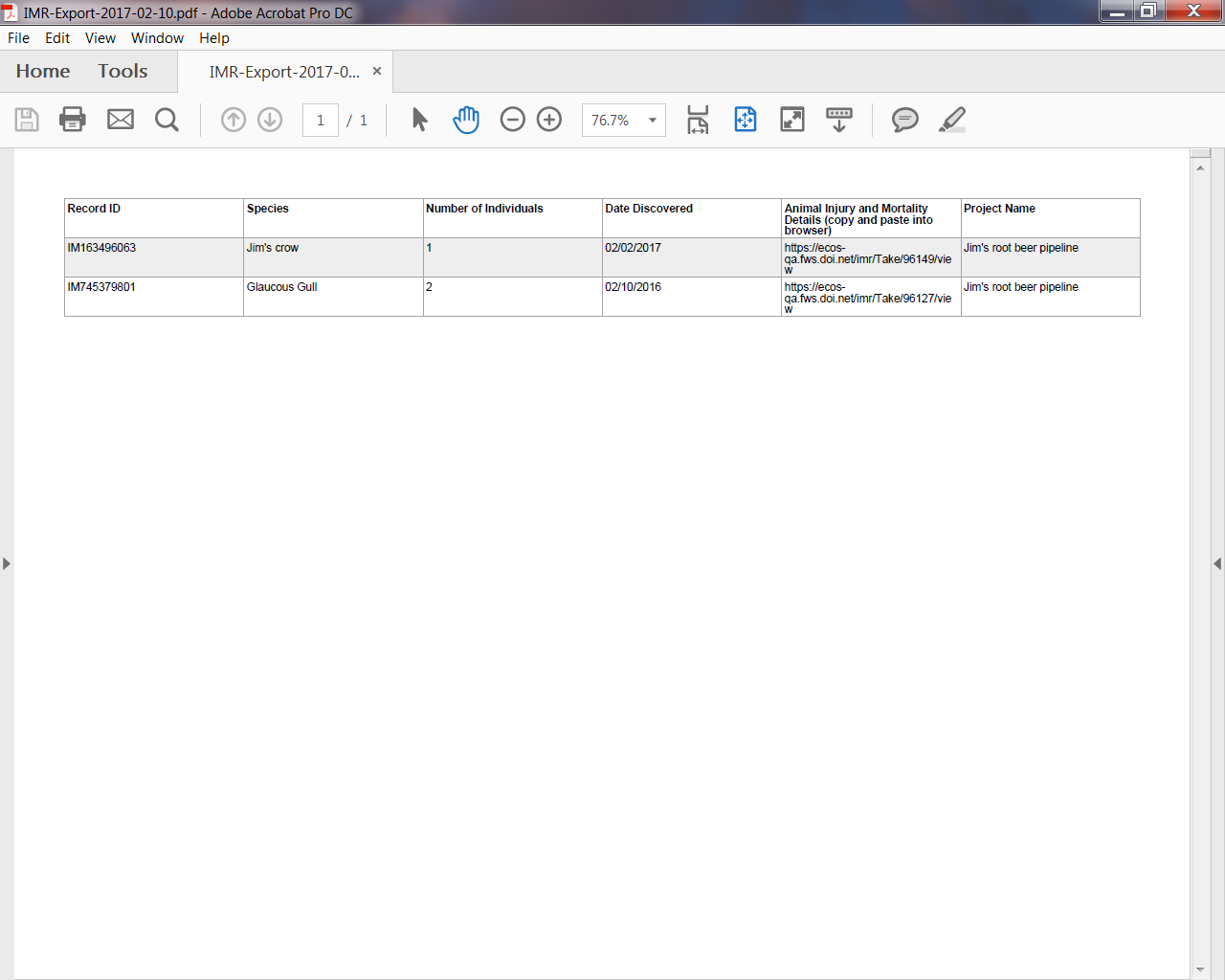
Creating a Nest Relocation/Removal Records and Exporting a Record Summary
Users can also create nest removal/relocation records. Nest Reporting Instructions (attached separately) are offered on the nest relocation/removal form to help users know what they should be entering here.
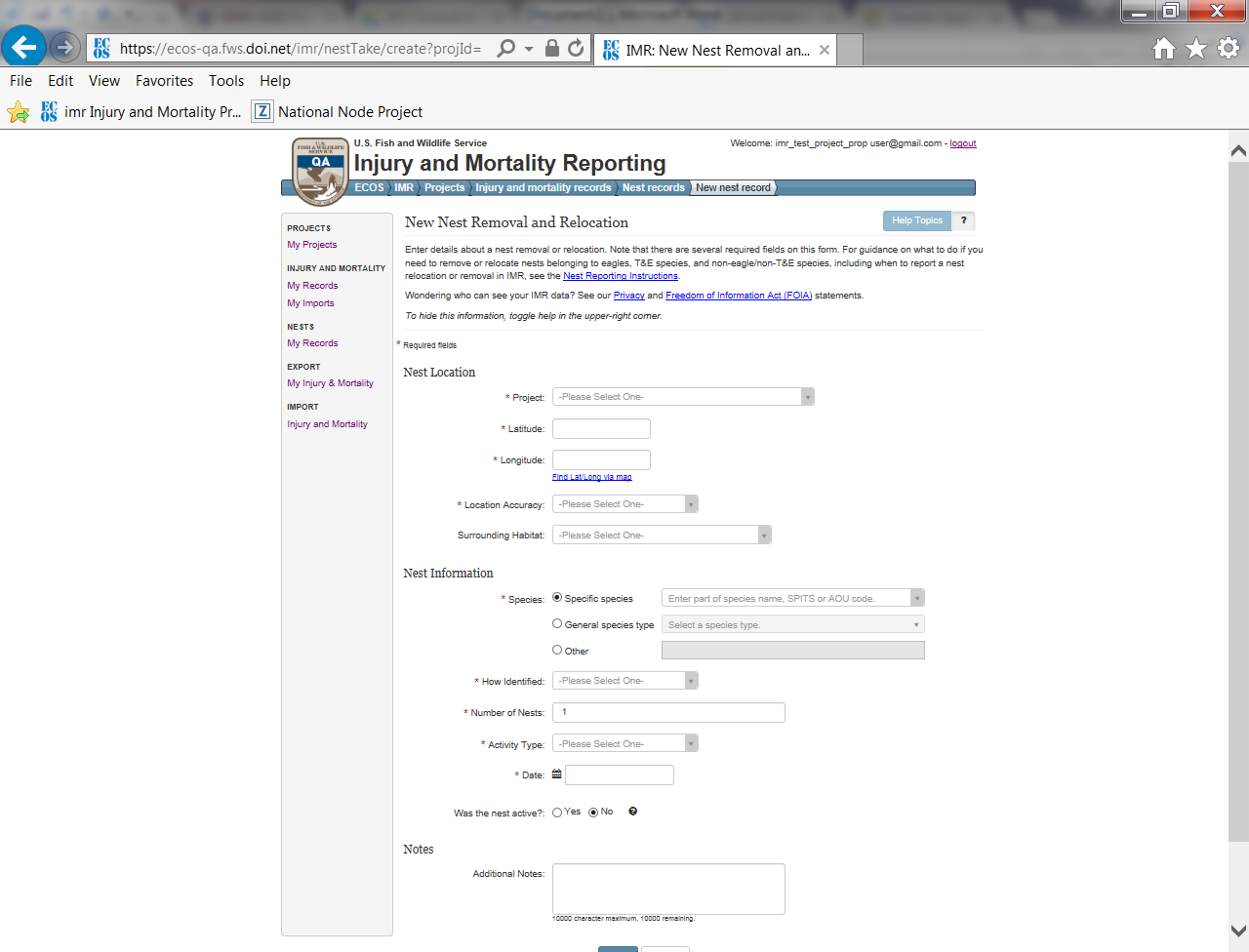
Once created, nest relocation/removal records are also viewable in list view and a summary report of these records can also be exported from the list view both in Pdf and Excel format.

The Excel version of the summary is formatted as pictured below. Anyone listed as a Project User on the project can view the full details associated with the record by copying and pasting the hyperlink pictured below in column E into their web browser. The user will be prompted to log into IMR to view the record details:
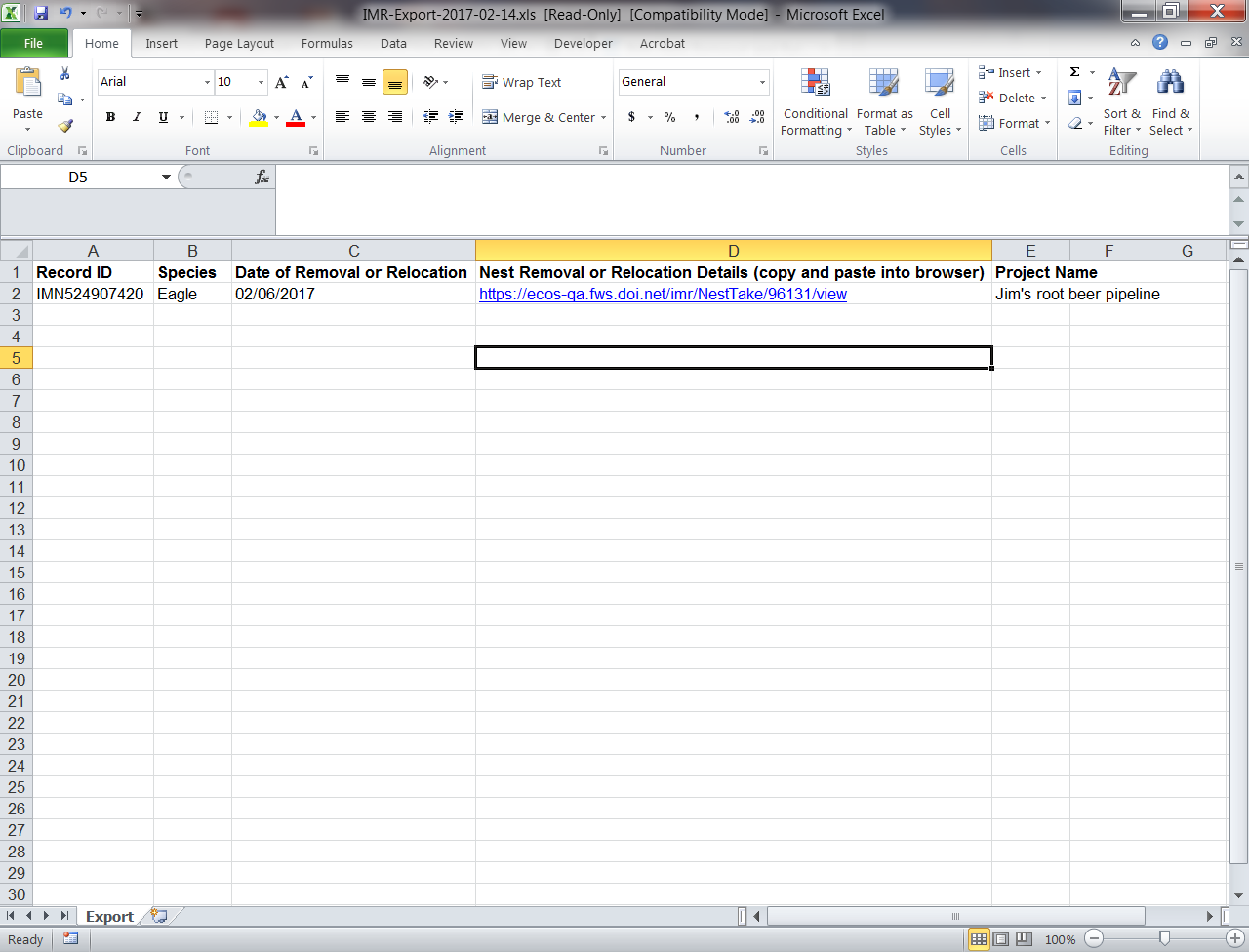
The Pdf version of the report is the same general format as the Excel version:
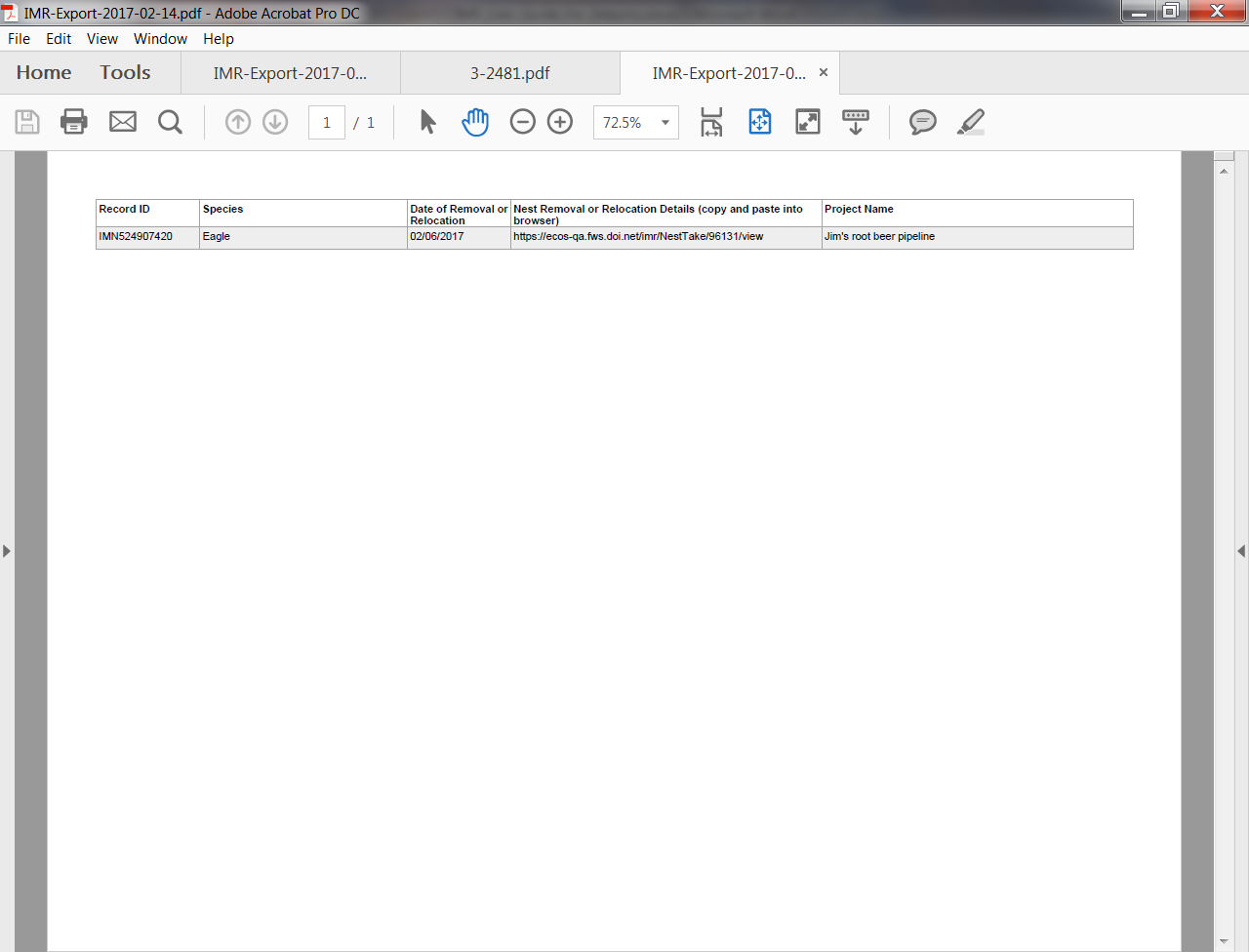
Exporting all details of injury/mortality records from IMR:
Users have the ability to export a
detailed report of all their injury/mortality records from IMR. This
can be done by clicking on the “My Injury & Mortality”
option in the “EXPORT” section of the left side menu bar.
The export report is in Excel report and includes the outputs from
nearly all fields (with the exception of the Features fields). Note:
this functionality does not currently exist for nest
relocation/removal records, but is likely to in a future version of
the database.

Users have the options of loading a spreadsheet of the data they’ve been collecting into IMR via the bulk upload tool in IMR. To do this, the data must be made to conform to the template format that the system expects, and the user must have created a Project record to associate the data with. An “IMR Injury and Mortality Example Import File” (attached separately) is available on the IMR Bulk Uploader page. The user can get to the Bulk Uploader page by clicking on “Injury and Mortality” in the IMPORT section of the left hand menu. The template spreadsheet and instructions for the Bulk Uploader can be accessed by clicking on the “Importing injury and mortality records” link (pictured below), which will bring them to the “Importing injury and mortality records” instructions page (second screen shot below) where they can download the “IMR Injury and Mortality Example Import File” and use that as their starting point for collecting data, or they can make existing datasets conform to that template. The instructions also include a list of all required and optional supported fields that the Bulk Uploader supports and the drop down options associated with those fields.

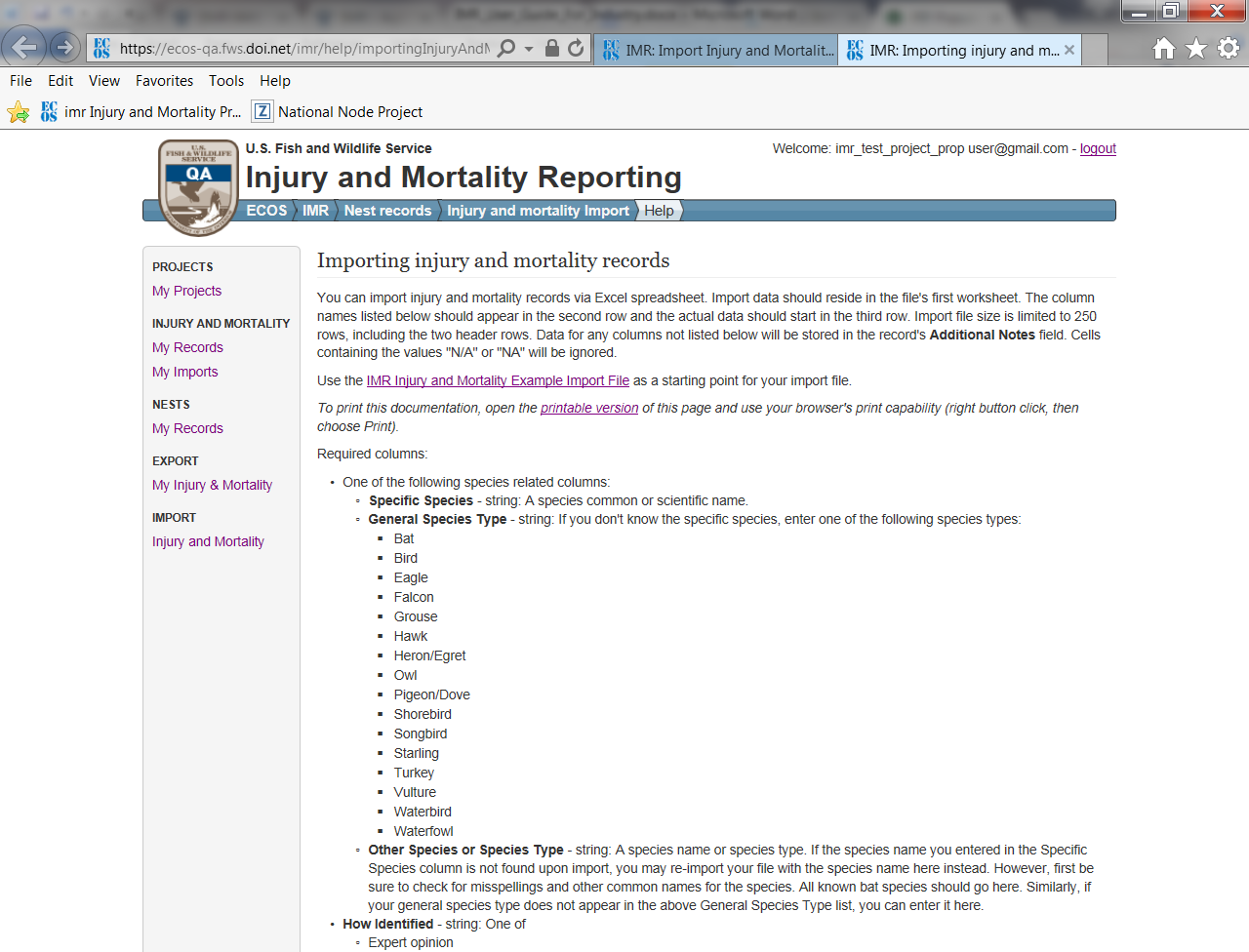
Helpful Hints for Using the Bulk Uploader
All uploaded datasets must have one blank row at the top above the column headers row. Headers start in row 2 and data starts in row 3. If the data does not conform to this format, the system will give you an error message telling you what it expects.
Drop down options for required columns must be filled in and spelled exactly as the system expects, or an error will be returned upon upload telling the user where data is missing or incorrectly spelled.
Users may add any number of additional columns to the spreadsheet and the system will accept them, but put all the data associated with those additional fields into a “Notes” field it creates in IMR system for each uploaded record in that dataset.
Data in supported optional columns will be accepted into the corresponding field in IMR if the data is in the correct format. If the data is not in the correct format (e.g. there are misspellings) you will not receive an error message from the system. However, the data will not be populated in the corresponding field in IMR; it will instead be put in the “Notes” field.
Example Error Message for Missing Blank First Row

Example Error Message for Incorrectly Spelled and Missing Data
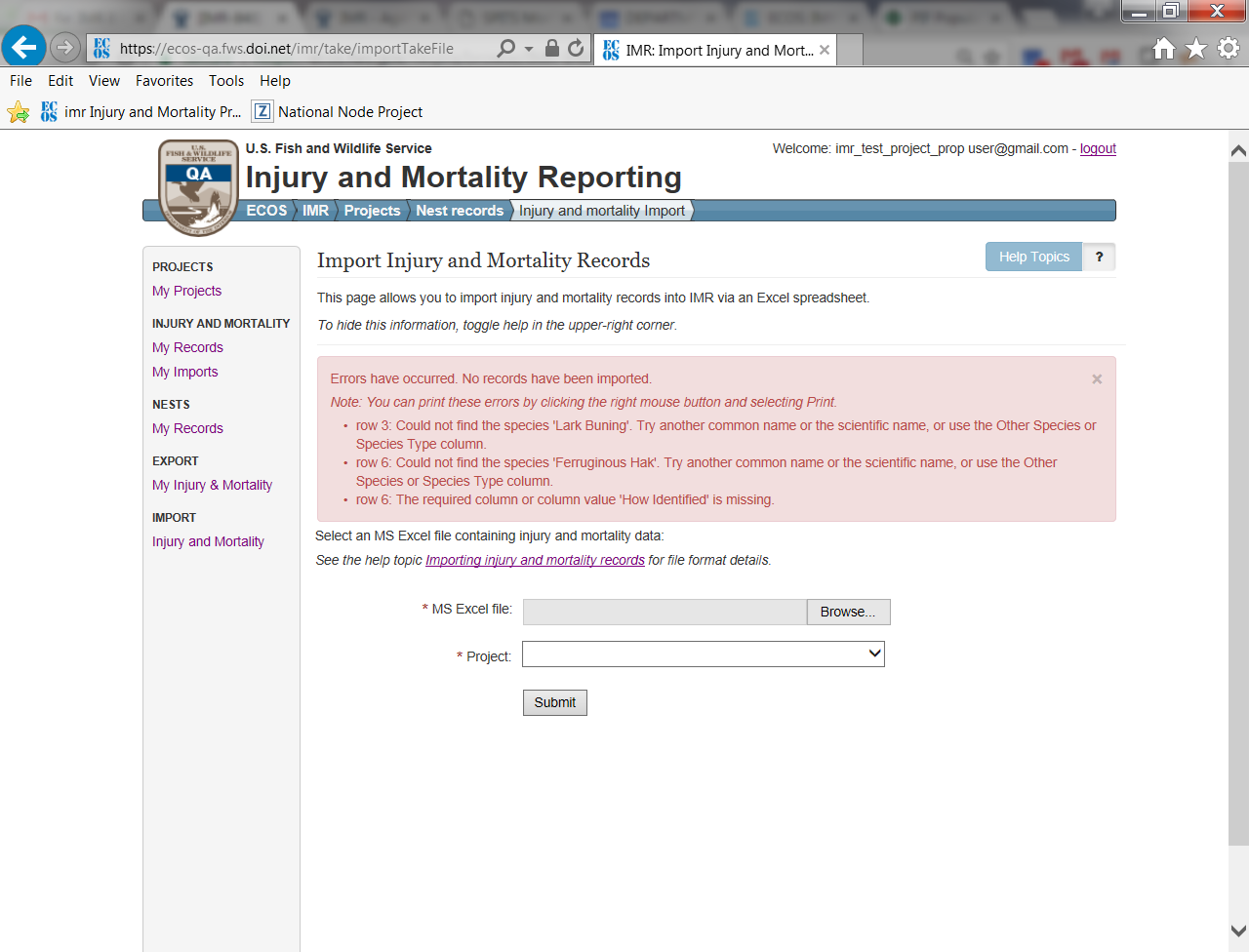
Example Notes Field (where information that exists in columns not supported by the bulk uploader will be placed)

Full List of IMR Fields and Drop-down Options:
*Indicates a required field
Project Record Fields (A project record must be created before injury/mortality records can be saved):
*Project Name - The unique name used to represent the project
*Project Type - The project type under which the project falls
Description - Free form text field for more information about project type
FWS Project Permits – Any FWS permits associated with the project
FWS Consultation Number – This is to be used if the company has engaged with the FWS on a consultation (e.g., requested an official species list through the Information Planning and Conservation system (IPaC)), and has received a consultation number
*Project Proponent - The entity with overall responsibility for the implementation and registration of the project; not the operating company who simply owns and finances the project. For instance, project proponent Western Wind is a developer that is owned by the Terra-Gen Power LLC operating company
*Primary Contact Name - The name of the person who is the primary contact for this project.
Primary Contact Title – The title of the primary contact
*Primary Contact Phone – The business phone number of the primary contact
Is Injury/Mortality Information Proprietary? – This is a yes/no radio button. If the user selects “yes” , a free form text box appears to allow the user to enter what they feel may be proprietary or sensitive and why.
Injury/Mortality Record Fields
Location Specimen Found
*Project - The name of the project the injury/mortality is associated with (user can pick from a drop down list of projects already created in the system)
*Latitude – The latitude of injury/mortality incident in decimal degrees
*Longitude – The longitude of injury/mortality incident in decimal degrees
*Location Accuracy – The level of accuracy of the latitude and longitude provided
Exact location
Nearest cross-street
Facility address
City
County
Township
HUC
Other
Surrounding Habitat – The habitat where the incident occurred
Agriculture
Desert
Forest
River or stream
Shrubland and grassland
Water
Urban
Wetland
Other
Specimen Information
*Species: One of the following species related columns needs to be populated:
Specific Species (see Specific Species spreadsheet for full list)
General Species Type
Bat
Bird
Eagle
Falcon
Grouse
Hawk
Heron/Egret
Owl
Pigeon/Dove
Shorebird
Songbird
Starling
Turkey
Vulture
Waterbird
Waterfowl
Other Species or Species Type - A species name or species type (this is for use if the species you want to enter is not found in either the “Specific Species” or “General Species Type” lists.
*How Identified
Expert opinion
Feather Atlas
Field guide
Guess
Other resource
Unknown
*Number of Individuals - The number of dead or injured individuals.
Out of the Ordinary Multiple Bird Incident – This is a check box a user can check if a mortality or injury incident occurs on the same day or on a series of consecutive days, in the same general location, and involves an unusual number of mortality or injury incidents involving the same or different species.
*Condition of Animal
Alive
Dead
Condition Details – Free form text box to add a little more detail on the condition, if desired
*How Found
Mortality survey
Incidental finding
Routine infrastructure survey
Structured research
Unknown
*Date Discovered - Date the animal was discovered
Date Collected - Date the animal was collected (if applicable)
Tissue or blood samples taken? (yes/no radio button)
Feather samples taken? (yes/no radio button)
*Did you see the mortality/injury event? (yes/no radio button)
*Suspected Cause - Users best guess at the cause of mortality or injury.
Barotrauma
Blinded/optical damage (radiant flux)
Collision
Collision with fence
Collision with solar panel/heliostat
Collision with vehicle
Collision with wind turbine
Collision with window
Collision with wire
Collision/electrocution
De-oiled
Determination pending
Disease
Drowned
Drowned (container/pit)
Drowned (entangled)
Drowned (evaporation pond)
Drowned (stock tank)
Electrocution
Emaciation
Entangled (net)
Entrapped
Exposure/dehydration
Fall from nest
Fire
Infection
Killed/injured by animal
Killed/injured by animal while entangled
Oiled
Poisoned
Poisoned (lead)
Poisoned (pesticide)
Salt encrustation
Salt toxicity
Scorched or singed
Shot
Starvation
Trapped
Trauma
Weather
Unknown
Other
Suspected Cause Details – Free form text field the user can use to add more details about the suspected cause, if desired
Sex
Female
Male
Multiple sexes
Unknown
Age
Adult
Sub-adult
Juvenile
Nestling
Egg
Multiple Ages
Unknown
How Aged – How the age of the animal was determined
Bloom and Clark 2001
Expert Opinion
Guess
Identification Guide to North American Birds (Pyle)
USFWS Feather Guide
Unknown
Other
Nearby Hazards and Environmental Attractants – Here users can select and “Add Feature” button that allows them to add a feature next to where the animal was found, indicate how far the animal was found from that feature, and add any other desired information.
Feature
Building
Distribution line
Evaporation pond
Fencing
Guy wires
Heliostat
PV panel
Pond net
Power pole
Road
Solar concentrating tower
Solar trough
Train tracks
Transmission line
Transmission tower
Vehicle
Water supply pond
Wind turbine
Other machinery
Other
Distance from Specimen
Feature Description
Animal or Parts Disposition - Where the animal ended up subsequent to its discovery.
*Disposition Information
If Condition is "Alive", Disposition can be one of:
Euthanized
Left in place
Rehab center
Released to wild
Transferred to other permittee
Veterinarian
Other
Unknown
If Condition is "Dead", Disposition can be one of:
Buried
Disposed of in trash
Disposition pending
Freezer off site
Freezer on site
Incinerated
Lab
Law Enforcement
Left in place
Sent to National Eagle Repository
Transferred to other permittee
Used in research trials (searcher efficiency and dead animal removal)
Other
Unknown
Disposition History – Free form text field to capture additional relevant information about the disposition, including Disposition history, since the Disposition can change over time.
Specimen Identification
USGS Band Number - The USGS Band Number, if one is found on the animal.
FWS Toe Tag ID - The USFWS Eagle Toe Tag ID, if one is attached to the animal.
Local Specimen Number - The local specimen number, if one has been attached to the animal.
Notes
Additional Notes – A free form text field for the user to add any additional notes, if desired
Supplemental Information
Weather on Day of Incident
Weather Conditions
Clear
Fog
Rain
Snow
Wind
Wind Speed – measurement in kph
Wind Direction
Temperature– measurement in degrees C
Humidity– measurement in %
Barometric Pressure– measurement in mb
Morphological Characteristics
Weight– measurement in grams
Wind Chord– measurement in mm
Hallux– measurement in mm
Culmen– measurement in mm
Tarsus – measurement in mm
Footpad – measurement in mm
Injury and Mortality Reporting (IMR) Privacy Statement:
In accordance with the Paperwork Reduction Act of 1995 (44 U.S.C. 3501, et seq.) and the Privacy Act of 1974 (5 U.S.C. 552a), please be advised:
The gathering of information on fish and wildlife is authorized by:
Bald and Golden Eagle Protection Act (16 U.S.C. 668), 50 CFR 22
Migratory Bird Treaty Act (16 U.S.C. 703-712), 50 CFR 21
General Provisions, 50 CFR 10
General Permit Procedures, 50 CFR 13
Wildlife Provisions (Import/export/transport), 50 CFR 14
Authorizing statutes can be found at Code of Federal Regulations and FWS Permits.
Information requested by this website is purely voluntary. However, if you have a permit with USFWS, submission of requested information is a condition of your permit under the above laws. Failure to provide all requested information indicated in your permit conditions may be sufficient cause for the U.S. Fish and Wildlife Service to revoke your permit.
Disclosures outside the Department of the Interior may be made without the consent of an individual under the routine uses listed below, if the disclosure is compatible with the purposes for which the record was collected. (Ref. 68 FR 52611, September 4, 2003).
Routine disclosure to subject matter experts and Federal, Tribal, State, local, and foreign agencies, for the purpose of obtaining advice relevant to making a decision on an application for a permit or when necessary to accomplish an FWS function related to this system of records.
Routine disclosure to Federal, Tribal, State, local, or foreign wildlife and plant agencies for the exchange of information on permits granted or denied to assure compliance with all applicable permitting requirements.
Routine disclosure to Federal, Tribal, State, and local authorities who need to know who is permitted to receive and rehabilitate sick, orphaned, and injured birds under the Migratory Bird Treaty Act and the Bald and Golden Eagle Protection Act; federally permitted rehabilitators; individuals seeking a permitted rehabilitator with whom to place a bird in need of care; and licensed veterinarians who receive, treat, or diagnose sick, orphaned, and injured birds.
Routine disclosure to the Department of Justice, or a court, adjudicative, or other administrative body or to a party in litigation before a court or adjudicative or administrative body, under certain circumstances.
Routine disclosure to the appropriate Federal, Tribal, State, local, or foreign governmental agency responsible for investigating, prosecuting, enforcing, or implementing statutes, rules, or licenses, when we become aware of a violation or potential violation of such statutes, rules, or licenses, or when we need to monitor activities associated with a permit or regulated use.
Routine disclosure to a congressional office in response to an inquiry to the office by the individual to whom the record pertains.
Routine disclosure to the Government Accountability Office or Congress when the information is required for the evaluation of the permit programs.
Routine disclosure to provide addresses obtained from the Internal Revenue Service to debt collection agencies for purposes of locating a debtor to collect or compromise a Federal claim against the debtor or to consumer reporting agencies to prepare a commercial credit report for use by the FWS.
For individuals, personal information such as home address and telephone number, financial data, and personal identifiers (social security number, birth date, etc.) will be removed prior to any release of the application.
The public reporting burden for information collection varies depending on the type of permit held. The relevant annual burden for Special Purpose – Utility Permit reporting is 6 hours. This burden estimate includes time for reviewing instructions, gathering and maintaining data, recordkeeping, and completing and reviewing the form. You may direct comments regarding the burden estimate or any other aspect of the form to the
Service Information Clearance Officer
U.S. Fish and Wildlife Service
Mail Stop 222
Arlington Square
U.S. Department of the Interior
1849 C Street, NW
Washington D.C. 20240
Injury and Mortality Reporting (IMR) Freedom of Information Act Notice:
The Freedom of Information Act (FOIA) provides the public with access to agency records unless the records are protected from disclosure by a specific exemption. Exemption 4 protects trade secrets and commercial or financial information that is privileged or confidential. When USFWS has reason to believe that information that is responsive to a FOIA request may be protected from disclosure under Exemption 4, USFWS will follow the DOI FOIA regulations for handling confidential information, and if required, inform the applicant/permittee of the request and provide an opportunity to object to release. The Department of the Interior’s FOIA regulations for handling confidential information are located at: 43CFR 2.26 – 2.36.
Nevertheless, when a company submits an application or report, it should clearly identify any information in its application or report that should be considered confidential business information. Since each dataset is considered and addressed on a case-by-case basis, the data USFWS deems proprietary may either be slightly more or less inclusive than this depending on the unique circumstances involved.
List of all Required and Optional Fields Supported by the Bulk Uploader:
Required columns:
One of the following species related columns:
Specific Species - string: A species common or scientific name.
General Species Type - string: If you don't know the specific species, enter one of the following species types:
Bat
Bird
Eagle
Falcon
Grouse
Hawk
Heron/Egret
Owl
Pigeon/Dove
Shorebird
Songbird
Starling
Turkey
Vulture
Waterbird
Waterfowl
Other Species or Species Type - string: A species name or species type. If the species name you entered in the Specific Species column is not found upon import, you may re-import your file with the species name here instead. However, first be sure to check for misspellings and other common names for the species. All known bat species should go here. Similarly, if your general species type does not appear in the above General Species Type list, you can enter it here.
How Identified - string: One of
Expert opinion
Feather Atlas
Field guide
Guess
Other resource
Unknown
Number of Individuals - integer: The number of dead or injured individuals.
How Found - string: One of
Mortality survey
Incidental finding
Routine infrastructure survey
Structured research
Unknown
Date Discovered - string: Date the animal was discovered, in the form mm/dd/yyyy (e.g., 10/23/2015)
One of the following pairs of columns:
Lat, Long:
Latitude - string: Latitude in decimal degrees (e.g., 41.54983)
Longitude - string: Longitude in decimal degrees (e.g., -105.98352)
County, State
County - string: County of the incident location. Must be just the county name. E.g., "Larimer", not "Larimer County". If you get an error indicating the county cannot be found, check the county spelling with a web search. Also, note certain special cases such as "Saint" vs "St.", "De Salle" vs "DeSalle", and "Valdez Cordova" vs "Valdez-Cordova" (in each example, the second is the accepted spelling).
State - string: State of the incident location. Full name or two letter abbreviation.
Location Accuracy - string: The accuracy of the specified incident location. One of
Exact location
Nearest cross-street
Facility address
City
County
Township
HUC
Other
Condition - string: The animal's condition. Alive or Dead.
Suspected Cause - string: Your best guess at the cause of mortality or injury. One of
Barotrauma
Blinded/optical damage (radiant flux)
Collision
Collision with fence
Collision with solar panel/heliostat
Collision with vehicle
Collision with wind turbine
Collision with window
Collision with wire
Collision/electrocution
De-oiled
Determination pending
Disease
Drowned
Drowned (container/pit)
Drowned (entangled)
Drowned (evaporation pond)
Drowned (stock tank)
Electrocution
Emaciation
Entangled (net)
Entrapped
Exposure/dehydration
Fall from nest
Fire
Infection
Killed/injured by animal
Killed/injured by animal while entangled
Oiled
Poisoned
Poisoned (lead)
Poisoned (pesticide)
Salt encrustation
Salt toxicity
Scorched or singed
Shot
Starvation
Trapped
Trauma
Weather
Unknown
Other
Event Observed - string: Whether someone saw the injury or mortality occur. Yes or No.
Disposition - string: Where the bird ended up subsequent to its discovery.
If Condition is "Alive", Disposition can be one of:
Euthanized
Left in place
Rehab center
Released to wild
Transferred to other permittee
Veterinarian
Other
Unknown
If Condition is "Dead", Disposition can be one of:
Buried
Disposed of in trash
Disposition pending
Freezer off site
Freezer on site
Incinerated
Lab
Law Enforcement
Left in place
Sent to National Eagle Repository
Transferred to other permittee
Used in research trials (searcher efficiency and dead animal removal)
Other
Unknown
Optional columns:
Date Collected - string: Date the animal was retrieved from the field, in the form mm/dd/yyyy (e.g., 10/23/2015)
Age - string: One of
Adult
Sub-adult
Juvenile
Nestling
Egg
Multiple ages
Unknown
How Aged - string: One of
Bloom & Clark 2001
Expert opinion
Guess
Identification Guide to North American Birds (Pyle)
USFWS Feather Guide
Other
Unknown
Other Aging Method - string: If you selected 'Other' for How Aged, use this field to specify how you determined the age of the animal.
Sex - string: One of
Male
Female
Multiple sexes
Unknown
Other How Identified - string: If you entered "Other" under How Identified, use this field to describe how you identified the animal.
Other Location Accuracy - string: If you specified "Other" under Location Accuracy, use this field to describe the location accuracy.
Condition Details - string: If alive, indicate if the animal is injured or sick. If dead, indicate if the animal is intact, freshly killed [eyes moist], semi-fresh [stiff], partially decomposed, feathers and/or bones, etc. If you specified "Other" under Condition, indicate the condition here.
Suspected Cause Details - string: Additional suspected cause details, such as what led you to conclude the suspected cause. If you entered "Other" under Suspected Cause, enter the cause here.
Other Disposition - string: If you entered "Other" under Disposition, describe the disposition here.
Surrounding Habitat - string: The habitat type where the animal was found. One of
Agriculture
Desert
Forest
River or stream
Shrubland and grassland
Urban
Water
Wetland
Other
Other Surrounding Habitat - string: If you chose "Other" for Surrounding Habitat, specify the surrounding habitat here.
USGS Band Number - string: The USGS Band Number, if one was found on the animal.
FWS Toe Tag ID - string: The five digit number on the FWS toe tag, if one was found on the animal.
Local Specimen Number - string: The local specimen number, if one has been attached to the animal.
Source Record ID - string: The unique identifier for this record in the source database.
Lab Name - string: Use this column if you specified a Disposition of "Lab". The name of the laboratory where the specimen was sent.
Rehab Center Name - string: Use this column if you specified a Disposition of "Rehab Center". The name of the rehab center where the animal was sent.
Rehab Center Info - string: Use this column if you specified a Disposition of "Rehab Center". If known, the USFWS permit number of the rehabilitation center and/or the name and phone number of a contact at the center.
Permittee Info - string: Use this column if you specified a Disposition of "Transferred to other permittee". The USFWS permit number, and/or the name and phone number, of the other permittee.
Law Enforcement Info - string: Use this column if you specified a Disposition of "Law Enforcement". The name and agency of the law enforcement individual that recovered the specimen.
Additional Notes - string: Any other notes you want to provide. The values for any columns beyond those provided above will be placed in this field.
| File Type | application/vnd.openxmlformats-officedocument.wordprocessingml.document |
| Author | Sadlowski, Meghan |
| File Modified | 0000-00-00 |
| File Created | 2021-01-20 |
© 2025 OMB.report | Privacy Policy